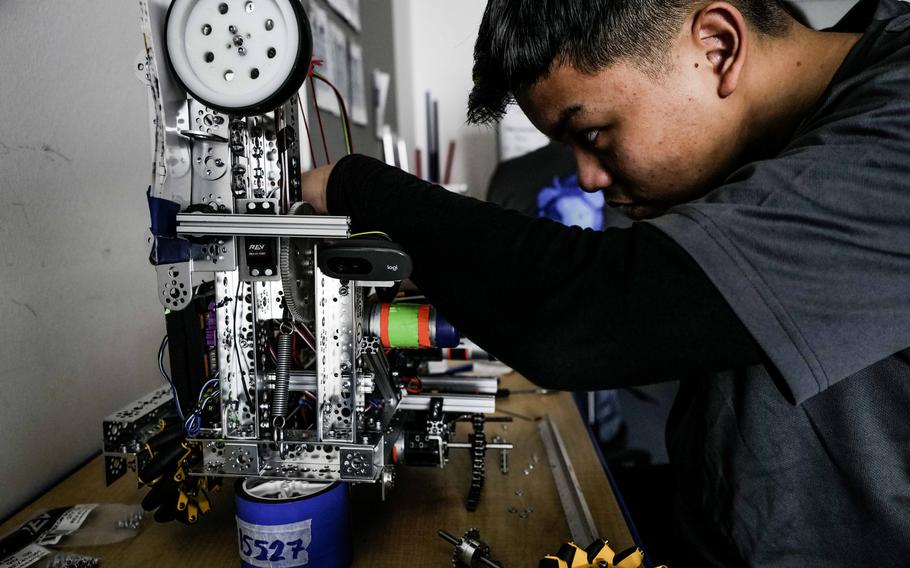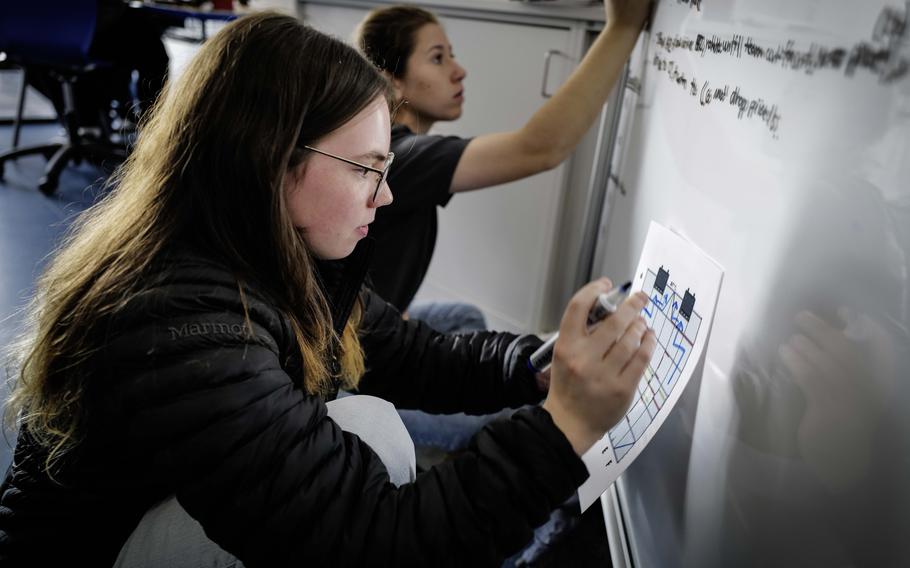
Deylan Acasio makes adjustments to the Ramstein robotics team’s robot, March 18, 2024, at Ramstein Air Base, Germany. The robot’s design won the team a spot at the First Tech Challenge World Championships in Houston, where it will compete against dozens of other designs. (Alexander Riedel/Stars and Stripes)
RAMSTEIN AIR BASE, Germany — Tucked away in a cramped corner workshop of Ramstein High School, a small group of young robotics engineers worked feverishly amid the cacophony of metal clanking and the occasional whir of machinery.
The team of six is on a tight deadline and racing to make final adjustments and improvements for a world championship in robotics.
At the heart of their work is a small robot; it’s a complex amalgamation of metal frames, wheels and an intricate network of wires that seem to defy order but bring coordinated life into the construct.
Amid this organized chaos, team leader Deylan Acasio is the picture of concentration. Hunched over a laptop, he sends a flurry of commands to the robot.
With a final keystroke, a wheel atop the robot spins. It’s the launcher for a paper airplane, a critical element in their strategy to conquer the latest challenge set forth by the First Tech Challenge World Championships.
During regional qualifiers against 21 other teams, the Ramstein Royals Robotics team recently clinched a spot for the FTC World Championships in Houston slated for April 17-20.
The six-member team of Acasio, Gwyn Cedarholm, Julia Adkins, Michael Sorensen, Douglas Morris and Xander Sanchez, is poised to represent the school and community on an international stage, competing against what organizers boast are some of the best young minds from around the globe.
This year, the FTC has posed a daunting task for competitors: create robots capable of navigating a field of obstacles to collect, transport and stack small hexagonal donut discs, dubbed “pixels.”
These plastic pieces, which roughly fit in the palm of a hand, must be carried across a designated game area, maneuvering under bars or flipping a one-way gate, to be stacked on a near-vertical board on the other side.
Teams aim to arrange these pixels into mosaics or in specified collection areas for additional points.
But the challenge doesn’t end there. Once the stacking time is over, the robots must launch a paper airplane beyond a certain threshold, then clinch onto a raised bar to lift themselves off the ground.
This multifaceted challenge demands a robot that is not only fast and precise but also lightweight and compact. What started as sketches in a notebook six months ago is now a buzzing little vehicle that propelled the team to the international stage.
“We designed the robot to be faster (than in previous designs) in order to sprint across the field and get as many pixels in as possible,” Acasio said. “It’s really quite difficult to configure to do all these tasks well.”
Now his team is working to add enhanced vision and object detection capabilities to their robot to garner points for autonomous operation, Acasio said.
The robotics team has embraced these challenges with excitement and determination, said coach Alfredo Rios, a mathematics teacher and Air Force veteran who has been guiding the team for the last three years.
“This year is pretty much one of the hardest challenges we’ve seen, but it’s fun, a lot of fun,” Rios said.
Alongside fellow championship-bound team Wiesbaden, the Royals secured their ticket to the international competition with superior design, documentation and teamwork, which won the competition’s “inspire” award.
The competition’s structure adds another layer of complexity, testing their ability to work as a cohesive unit, as teams are paired with an “ally” for each match.
These alliances are formed without prior knowledge of who they will be paired with or how their ally’s robot functions. This unpredictability forces teams to design robots with versatility in mind.
“The competitors so far have been really nice, and we’re able to work with other teams to see and learn from what they’re doing,” Cedarholm said. “It’s a great opportunity for us to help out others and get help and see what might work with our design.”

Gwyn Cedarholm, left, and Julia Adkins work on the algorithm of their robot at Ramstein High School at Ramstein Air Base, Germany, March 18, 2024. The robot has to move under remote control and autonomously to garner the most points. (Alexander Riedel/Stars and Stripes)
All of the team members, ranging in age from 15 to 17, are interested in careers in science, technology and engineering, they say, although most don’t yet know where their academic journey is going to lead.
“Being in a group like this, where we can collaborate and problem solve is really helpful no matter where we go in life, I think,” Adkins said.
The upcoming journey to Houston represents a substantial financial undertaking. While the Department of Defense Education Activity covered much of the $4,000 robot construct, at DOD schools the students can’t represent sponsors the way students at other schools can in order to raise travel funds.
“What’s special about these guys is that they’ve done all of it on their own,” Rios said.
The team received support from private organizations on base, including the Ramstein enlisted spouses club, but still hopes for support from the military community on the way to the $12,000 the team will need to travel to the championships.
“We’re just really excited to go to internationals and to learn a lot over there while having some fun,” Adkins said. “And I hope that we can build the program here even stronger for the next year based on our experiences there.”